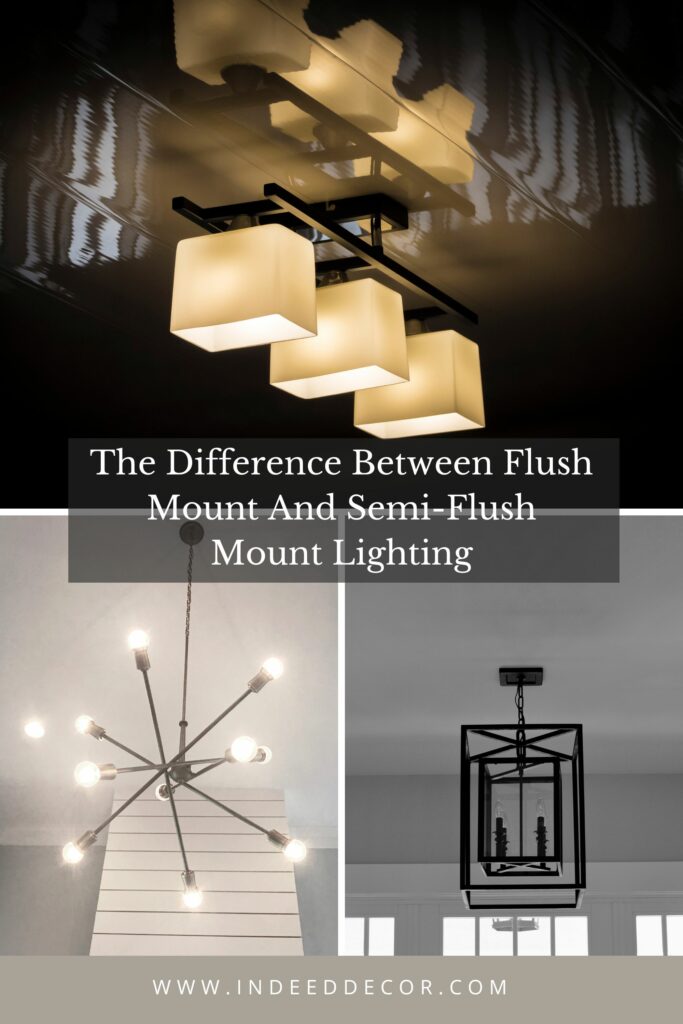When it comes time to choose lights for your home, it can be an intimidating decision.
You’ll quickly discover an endless sea of options and confusing terms that can feel overwhelming!
In this article, we hope to demystify some of these details and help you better understand two types of ceiling lights used in modern homes.
Ceiling lights are a great way to light up a space evenly. They’re seen in all rooms in a house, most often used for ambient lighting (as opposed to more direct task lighting).
The best thing about ceiling lights is that they take up practically no usable space in the room, being out of the way but still very practical.
They also come in a huge range of styles, finishes, and materials to match pretty much any room.
There are five types of ceiling lights you’ll come across: Chandelier, pendant, track, flush and semi-flush. Today, we’ll talk about the most popular types: Flush and semi-flush lights!
What is the difference between flush mount and semi-flush mount lighting?
This article will cover:
- What flush mount lighting is
- What semi-flush mount lighting is
- The difference between the two
- Pros and cons of each
- How to choose the correct light for you.
Let’s get into it!
What Is Flush Mount Lighting?

To start, let’s talk about flush mount lighting.
These lights are mounted directly against your ceiling, with no gap (or a very, very small gap) above the fixture. They can come in countless shapes, styles and colors, though they tend to be more minimalist and simple.
The flush nature of these lights make them seem mounted directly onto the ceiling. This helps to blend the light with the ceiling, and stop it from distracting from the rest of the room.
The simplicity and “hidden away” look of flush lights also helps them be unobtrusive, letting your decor really shine without distraction.
Also useful is their lack of vertical height. They take up very little space, helping the room feel bigger and less crowded. They also won’t get in the way of tall people or furniture being moved around.
What is Semi-Flush Mount Lighting?

Semi-flush lights are similar to flush fixtures, but have a small gap between the ceiling and the main structure of the light. This is normally about 2 inches tall.
Often, this means there is a visible center stem that holds the light up.
Generally, these lights are more intricate and ornate than flush lights and thus suit more detailed styles. Of course, these rules can always be broken by individual lights; it all depends on where you look.
If the light hangs 8 inches or more from the ceiling, then it is no longer a semi-flush light! Instead, it would be considered a pendant or chandelier light depending on its design.
The practical features of semi-flush lights mostly center around the direction they send light in. Because they hang slightly away from the ceiling, some light is reflected up and off the ceiling to create soft, far-reaching ambient light.
This is especially good in calming, large spaces like living rooms and bedrooms.
The Difference Between Flush Mount Lights And Semi-Flush Mount Lights
It can be a bit confusing to distinguish between these two types, since at a glance they can look pretty similar. Let’s identify exactly what sets them apart from each other:
Characteristics
The biggest difference is that flush lights sit completely flat against the ceiling, whereas semi-flush lights hang slightly below it.
To count as a semi-flush light, there has to be between 2 and 8 inches between the light fixture and the ceiling.
Often, semi-flush and flush lights can look very similar. However, semi-flush lights tend to be more detailed and ornate, where flush lights are usually more minimalist. Of course, there are always exceptions to the rules.
Whether you want a highly ornate flush light, or a super simple, minimalist semi-flush light, we’re sure you can find one somewhere.
Uses
For very low ceilings, you’ll want to use a flush light. These take up the least space in the room, allowing it to feel less cramped overall!
In very small spaces, lower hanging lights may even restrict movement or bump people’s heads.
However, if placed above a table or counter, you can sometimes get away with lower hanging lights in low-ceilinged spaces.
In a low to medium height room, a semi-flush light will probably work best. These will help illuminate the entire space without making it feel cramped or getting in the way. They also offer a wider range of styles to choose from.
In a high-ceilinged room, semi-flush and flush lights probably won’t work. You’d be better looking at chandelier or pendant lights to fill out the space.
Flush and semi-flush lights are best for illuminating large spaces with soft, ambient light. They aren’t a good choice if you want strong, directional light for task areas, such as offices or kitchens. This should be kept in mind when choosing your light fittings!
If you want a light to highlight a piece of art, architectural feature, or workspace, then a pendant, wall or floor light would probably be better.
Pros And Cons

Pros And Cons Of Flush Mount Lighting
The biggest benefit of flush lighting is its compact shape.
It lays flat against the ceiling, meaning it won’t hit tall people on the head or get in the way of furniture being moved. This is great for areas where this happens often, like garages, hallways and entryways.
It also looks great in smaller spaces, where a hanging light will feel cramped!
However, a major con of flush lighting comes when trying to change the bulb.
Because of their shape, flush lights must be completely removed every time you want to change out the bulb— which can be time consuming and annoying. If they’re made of a delicate material like glass, this may also increase risk of damage or breakage.
Additionally, flush lights tend to have less choice when it comes to style. You might find it difficult to get a very specific style of light in flush lighting.
Pros And Cons of Semi-Flush Mount Lighting
These lights are wonderful in small to medium spaces that need a little extra pizazz.
They often come in a huge variety of styles and finishes, letting you perfect the feel of your space. Dining rooms and kitchens are where they work especially well, often being used over dining room tables as a focal point of the room.
The bulb in semi-flush lights is also easier to replace. You only need to remove the outer cover of the light to do this, rather than the whole fixture. This is quicker, easier, and less likely to break the light.
However, they will need to be cleaned more often than flush lights. Their hanging nature means there are more surfaces for dust to collect, requiring regular wiping.
They will also take up a lot of space in low ceilinged rooms. This can make things feel cramped.
How To Choose The Correct Flush Light: Top Things To Consider
Here are the things you should consider when choosing between flush lights! These will depend on the room you’re installing the light into, as well as your personal taste and needs.
Ceiling Height

This is probably the most important thing to consider when choosing a light.
You should think about how much space is needed in your room, and how much is already available. Will furniture be regularly moved through? Are there a lot of tall people in your family?
If the ceiling is 90 inches or less, you should choose a flush light. Any other choice will probably feel cramped and unwieldy.
If your ceiling is very high (anything 20 ft or more), then flush and semi-flush lights are probably the wrong choice for you! In this case, it would be better to choose a chandelier or pendant light. Otherwise, the space will feel empty and strange.
Room Purpose
Consider what the room will be used for.
Hallways and entryways often have tall furniture moving through them.
This can make hanging lights annoying and precarious, especially if they’re made of a delicate material. For this reason, flush lights might be the better option.
You should also think about whether you want strong or soft lighting. Task-focused spaces like offices and kitchens should have stronger, directional light.
On the other hand, relaxed dining rooms or bedrooms should have ambient lighting to keep things calm. Flush lights are great for this!
Style

You shouldn’t be too limited by style when it comes to flush lights, since they’re an incredibly popular style with countless designs available.
However, semi-flush lights do tend to have more adventurous, ornate styles available.
Consider the existing style of your room, its furniture and current decor, as well as your desired feel. With these in mind, think about what light would best compliment them. You should also keep the existing color scheme of your space in mind to make sure your light won’t clash with it.
A great way to get an idea of what you want is to look at images online that show a similar feel and style to what you want. Pay attention to what lights they use, and how they affect the space!
Size
This is another very important consideration when choosing your light fixture.
In smaller spaces, you’ll probably want a flush mount light since they take up as little vertical space as possible. This means the room won’t feel cramped, and the light won’t get in the way.
On the other hand, a room with taller ceilings will need a lower-hanging light. This is to make sure the light illuminates the whole space, and to stop the room feeling empty.
If your ceiling is very high, even semi-flush may not be enough! Instead, you should look at pendant and chandelier lights.
If you have a small space but still want an interesting, stylish light fixture, semi-flush is a great choice.
These lights often have much more ornate designs, allowing them to become more of a focal point of the room. They work great over tables and countertops for this reason.
You should pay careful attention to the individual semi-flush light you’re considering, since they can vary wildly in hanging length.
While they are generally between 2 and 8 inches from the ceiling, a few inches can make a huge difference to the feel of your room!
Brightness

This will depend greatly on the individual light you’re looking at. However, lower hanging lights will tend to illuminate the space more evenly, making them seem brighter.
In a larger space, consider semi-flush lights over flush. This will avoid the room having dark spots, or not being completely lit. They also work great for helping a high-ceiling feel less looming and empty.
Some lights offer dimmer switches, or even color changing remotes. This is especially useful for a bedroom or living area, where you may want different strengths of lighting at different times of the day.
It’s also just kind of cool.
If you want these features, make sure they are included with your chosen fixture!
Bulbs
You should make sure your bulbs match your fixture if you buy them separately. Some fixtures only take certain types and wattages of bulbs, and can become damaged if used with the wrong ones.
This information should be included with the packaging of your chosen light.
Bulbs are a complicated topic that can’t be fully explored here, so you should probably do a little more research into them.
When choosing a bulb, consider cost efficiency, purpose, safety and overall cost. Your choice will be between halogen, fluorescent, LED and incandescent lights!
The Bottom Line
Like we said, lights are more complicated than you might think!
It can be a hard topic to understand if you don’t know the common lingo and technicalities of lighting. We hope this article has cleared some of this confusion up for you, and made your choice easier and more informed.
Good luck and happy decorating!







